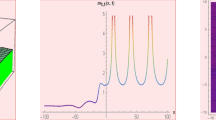Abstract
In this present paper, we deal with a generalized Lengyel–Epstein model with the zero-flux boundary conditions. Firstly, we give an attraction region and the boundedness estimates of the solutions to the parabolic equations. Hereafter, one performs the local and global stability of the unique positive equilibrium. The first Lyapunov exponent technique and the normal form theory are employed to investigate the directions of the Hopf bifurcation, respectively. It is found that the supercritical or the subcritical may occur in the generalized Lengyel–Epstein model. Finally, we explore the steady states of the elliptic equations. The boundedness, the nonexistence, and the existence of the steady states are performed. Numerical experiments well verify the theoretical analysis. Relevant theoretical results illustrate that the diffusion rates of the substance can affect the dynamical behaviors of such a generalized Lengyel–Epstein model.



Similar content being viewed by others
References
A. Cassani, A. Monteverde, M. Piumetti, Belousov–Zhabotinsky type reactions: the non-linear behavior of chemical systems. J. Math. Chem. 59, 792–826 (2021)
J. Sarria-Gonzalez, I. Sgura, M.R. Ricard, Bifurcations in twinkling patterns for the Lengyel–Epstein reaction-diffusion model. Int. J. Bifur. Chaos 31(11), 2150164 (2021)
N.I. Kavallaris, R. Barreira, A. Madzvamuse, Dynamics of shadow system of a singular Gierer-Meinhardt system on an evolving domain. J. Nonlinear Sci. 31(1), 5 (2021)
B. Aguda, R. Larter, Sustained oscillations and bistability in a detailed mechanism of the peroxidase–oxidase reaction. J. Am. Chem. Soc. 112, 2167–2173 (1990)
E. Freire, L. Pizarro, A. Rodríguez-Luis, F.F. Sánchez, Multiparametric bifurcations in an enzyme-catalyzed reaction model. Int. J. Bifurcat. Chaos 15, 905–947 (2004)
J. Maseko, M. Alamgir, I. Epstein, Bifurcation analysis of a system of coupled chemical oscillators: bromate–chlorite–iodide. Physica D 19, 153–161 (1986)
I. Lengyel, G. Rabai, I.R. Epstein, Experimental and modeling study of oscillations in the chlorine dioxide–iodine–malonic acid reaction. J. Am. Chem. Soc. 112, 9104–9110 (1990)
A.M. Zhabotinskii, Periodic course of the oxidation of malonic acid in a solution (studies on the kinetics of Belousovs reaction). Biofizika 9, 306–311 (1964)
I. Lengyel, I.R. Epstein, Diffusion-induced instability in chemically reacting systems: steady-state multiplicity, oscillation, and chaos. J. Nonlinear Sci. 1, 69–76 (1991)
T.B.A.F. Tayloy Jr., Helical Turing patterns in the Lengyel–Epstein model in thin cylindrical layers. Chaos 25, 064308 (2015)
J.Y. Jin, J.P. Shi, J.J. Wei et al., Bifurcations of patterned solutions in the diffusive Lengyel–Epstein system of CIMA chemical reactions. Rocky Mount. J. Math. 43(5), 1637–1674 (2013)
H. Merdan, S. Kayan, Hopf bifurcations in Lengyel–Epstein reaction-diffusion model with discrete time delay. Nonlinear Dyn. 79(3), 1757–1770 (2015)
D. Mansouri, S. Abdelmalek, S. Bendoukha, On the asymptotic stability of the time-fractional Lengyel–Epstein system. Comput. Math. Appl. 78, 1415–1430 (2019)
L.M. Valenzuela, G. Ble, M. Falconi, Hopf and Bautin bifurcations in a generalized Lengyel–Epstein system. J. Math. Chem. 58, 497–515 (2020)
M.X. Chen, R.C. Wu, Y.C. Xu, Dynamics of a depletion-type Gierer–Meinhardt model with Langmuir–Hinshelwood reaction scheme. Discret. Contin. Dyn. Syst. B 27(4), 2275–2312 (2022)
S. Wiggins, Introduction to Applied Nonlinear Dynamical Systems and Chaos, 2nd edn. (Springer, New York, 1990)
M.X. Chen, R.C. Wu, X.H. Wang, Non-constant steady states and Hopf bifurcation of a species interaction model. Commun. Nonlinear Sci. Numer. Simul. 116, 106846 (2023)
B.D. Hassard, N.D. Kazarinoff, Y.H. Wan, Theory and Applications of Hopf Bifurcation (Cambridge University Press, Cambridge, 1981)
X.X. Fu, R.C. Wu, M.X. Chen, Spatiotemporal complexity in a diffusive Brusselator model. J. Chem. Math. 59, 2344–2367 (2021)
M.X. Chen, R.C. Wu, L.P. Chen, Spatiotemporal complexity in a Leslie–Gower type predator-prey model near Turing–Hopf point. Chaos Solit. Fract. 153, 111509 (2021)
M.X. Chen, R.C. Wu, B. Liu et al., Spatiotemporal dynamics in a ratio-dependent predator-prey model with time delay near the Turing–Hopf bifurcation point. Commun. Nonlinear Sci. Numer. Simul. 77, 141–167 (2019)
S.H. Wu, Y.L. Song, Stability and spatiotemporal dynamics in a diffusive predator-prey with nonlocal prey competition. Nonlinear Anal. 48, 12–39 (2019)
Y. Lou, W.M. Ni, Diffusion, self-diffusion and cross-diffusion. J. Differ. Equ. 131(1), 79–131 (1996)
M.X. Chen, R.C. Wu, Patterns in the predator-prey system with network connection and harvesting policy. Math. Meth. Appl. Sci. 5, 1–22 (2022)
C.V. Pao, Nonlinear Parabolic and Elliptic Equations (Springer, New York, 1992)
Acknowledgements
The authors express their sincere gratitude to the anonymous referee for her/his careful reading and helpful suggestions, which led to great improvements of the presentation of this paper. This work was supported by China Postdoctoral Science Foundation (No. 2021M701118).
Author information
Authors and Affiliations
Corresponding author
Ethics declarations
Confict of interest
The authors declare that there are no conficts of interest.
Additional information
Publisher's Note
Springer Nature remains neutral with regard to jurisdictional claims in published maps and institutional affiliations.
Rights and permissions
Springer Nature or its licensor (e.g. a society or other partner) holds exclusive rights to this article under a publishing agreement with the author(s) or other rightsholder(s); author self-archiving of the accepted manuscript version of this article is solely governed by the terms of such publishing agreement and applicable law.
About this article
Cite this article
Chen, M., Wang, T. Qualitative analysis and Hopf bifurcation of a generalized Lengyel–Epstein model. J Math Chem 61, 166–192 (2023). https://doi.org/10.1007/s10910-022-01418-8
Received:
Accepted:
Published:
Issue Date:
DOI: https://doi.org/10.1007/s10910-022-01418-8



